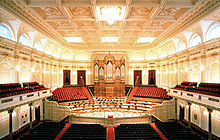Lyric Performing Arts Center
 Post-renovation | |
 | |
| Address | 124 West Mount Royal Avenue Baltimore, Maryland United States |
|---|---|
| Owner | Lyric Foundation Inc. |
| Type | Performing arts center |
| Capacity | 2,564 |
| Opened | 31 October 1894 |
| Website | |
| www | |
Lyric Theatre | |
| Built | 1893 |
| Architect | T. Henry Randall |
| Architectural style | Renaissance |
| NRHP reference No. | 86000131[1] |
| Added to NRHP | 23 January 1986 |
The Lyric Opera House is a music venue in Baltimore, Maryland, United States, located close to the University of Baltimore. In 2010, the Lyric was renamed the Patricia and Arthur Modell Performing Arts Center at the Lyric.[2]
The building was modeled after the Concertgebouw concert hall in Amsterdam, and it was inaugurated on 31 October 1894 as The Music Hall[3] with a performance by the Boston Symphony Orchestra and Australian opera singer Nellie Melba as the featured soloist. Beginning 1904, it was also used for touring performances by the Metropolitan Opera, and from 1950, it was the home of the Baltimore Opera Company until the company's liquidation in 2009.
The Lyric has been the home of the Lyric Opera Baltimore company since 2011. It was founded after the demise of Baltimore Lyric Opera.[4]
History

Opera and music at the Lyric
Prior to the 1909 purchase of the building on behalf of the Metropolitan Opera by Otto Kahn, Oscar Hammerstein I presented an opera season and began to make plans to remodel it by enlarging the stage area. However Kahn's purchase caused the venue's name to be changed to the Lyric Theatre.[3] and firmed up the continuity of the Metropolitan Opera's annual visits. In the early 20th century, the Lyric Opera featured opera tenor Enrico Caruso who appeared there with the Metropolitan Opera in a performance of Flotow's Martha.
In 1950, building on earlier amateur efforts, the Baltimore Opera was formally established as the Baltimore Civic Opera Company, with the famous American soprano Rosa Ponselle as its first artistic director. She brought Beverly Sills to Baltimore for a production of Manon in 1952. By 1970, the name was changed to Baltimore Opera Company and had become firmly established at the Lyric.
Having been modeled on the Concertgebouw, the Lyric was primarily used as a concert hall. 1916 saw the founding of the Baltimore Symphony Orchestra which presented performances there until 1982, while the building was purchased from Kahn in 1920 and a significant renovation created an enlarged balcony with seating capacity reaching 2,800. In March 1974, the Lyric's 75th anniversary featured the return of the Boston Symphony Orchestra, and throughout these years, the Philadelphia Orchestra made regular appearces in Baltimore until April 1980. A highlight was the 1934 debut of Rachmaninoff's Rhapsody on a Theme of Paganini, with the composer at the piano.
Other events
Many different kinds of events were presented at the Lyric, including sporting events such as the 1905 lightweight boxing fight between Joe Gans, the lightweight champion, and Mike Sullivan and the 1906 wrestling bout between Gus Schoenlein and the world champion, George Hackenschmit, the world champion of the time. The first public showing of electric cooking in Baltimore took place, as well as hosting speakers like Aimee Semple McPherson, Will Rogers, Richard Byrd, Clarence Darrow, Amelia Earhart, Charles Lindbergh and William Jennings Bryan.
Performers appearing at the Lyric included in April/May 1984 Yul Brynner who starred in The King and I which over 70,000 people attended in four weeks. That same year, Patti Labelle's performances sold out five performances while, in 1987, Cats played to over 75,000 people.
Creating an opera house
Major renovations from 1980-1982 completed its transformation into an opera house.
References
Notes
- ^ "National Register Information System". National Register of Historic Places. National Park Service. April 15, 2008.
- ^ Tim Smith, After $3.5M gift "Lyric Opera House to carry Modell name" in Baltimore Sun, 7 September 2010. Retrieved 12 December 2013
- ^ a b Lyric Opera House history on lyricoperahouse.com. Retrieved 12 December 2013
- ^ Tim Smith, "Baltimore Opera Company to close", The Baltimore Sun, Friday, March 13, 2009.
External links
- Buildings and structures on the National Register of Historic Places in Baltimore, Maryland
- Opera houses in the United States
- Theatres on the National Register of Historic Places in Maryland
- Theatres in Maryland
- Visitor attractions in Baltimore, Maryland
- Event venues established in 1894
- Theatres completed in 1894
- 1894 establishments in Maryland
- Mount Vernon, Baltimore



